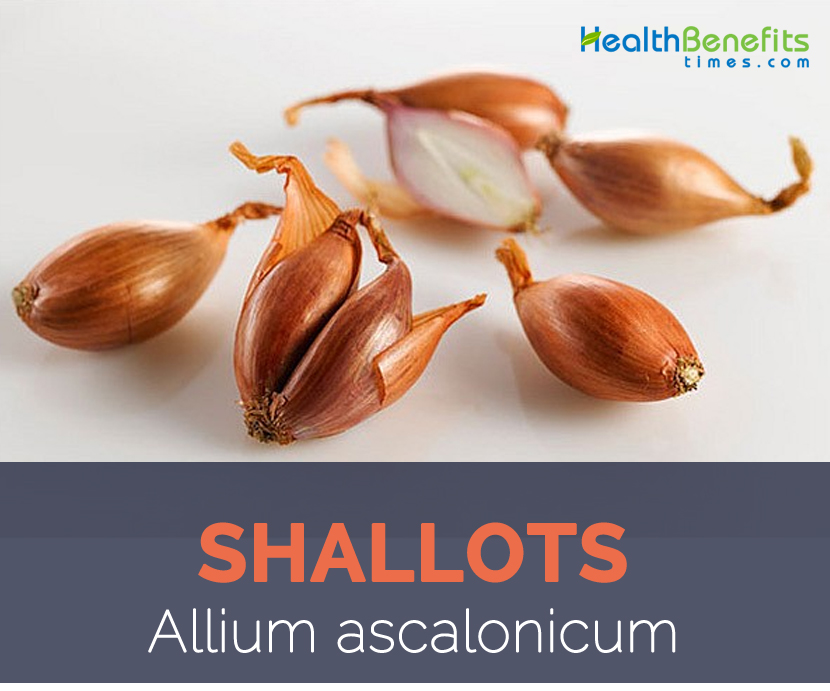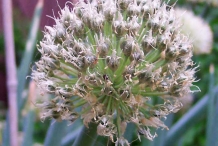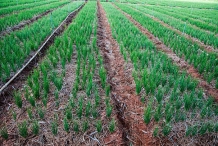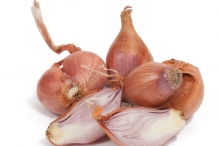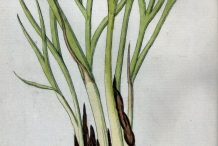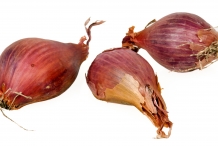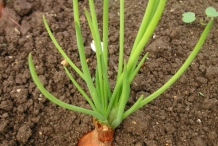Plant
Shallot is a biennial clustered, caespitose bulbous herb growing up to 63 cm tall and found growing in temperate and subtropical conditions with full sun. It prefers well-drained, friable and moderately fertile soils such as sandy loams. Shallot plant has adventitious roots. Leaves are distichous, cylindrical, hollow, 20–50 cm by 1–5 mm and 3–5 angled. Flower is campanulate, purplish with six tepals arranged in two whorls, six stamens and a pistil longer than the tepals. Plant has obovoid–globose fruit with concave nectaries covered by hood like projections at the base. Style exserted.
Bulb
Shallot is petite members of the Allium plant family, which includes onions, garlic and chives. Like garlic, shallots are formed in clusters of offsets with a head composed of multiple cloves. Shallot bulb is narrowly ovoid to ellipsoid, 1–4 cm in diameter and has white, membranous coat which is often tinged with golden brown to rose-red color. It has pulpy white flesh with some green coloring. An average weight of the bulb is about 25 gram. Normally it has milder and more aromatic flavor and taste somewhat like onions milder and delicious. Shallots generally have two to three bulbs per segment and are aromatic and savory when raw. As they cook, their flavor becomes more delicate and sweet. However, similar to garlic and onions, shallots cause irritation in the eye when sliced. Due to its wonderful taste it is consumed throughout the world.
History
Shallot occurs unexpectedly in Central and Eastern China (in Anhui, Fujian, Guangdong, Guangxi, Guizhou, Hainan, Henan, Hubei, Hunan, Jiangxi and Zhejiang provinces) and in Japan, Korea, Russia and Mongolia. It is extensively grown in China and Japan. It is also cultivated in Southeast Asia (Cambodia, Laos, Vietnam, Thailand, Myanmar, Malaysia, Singapore and Indonesia) and introduced with oriental emigrants from this region into further areas, e.g. the United States (Hawaii, California) and Cuba. At present it is grown throughout the world due to its wonderful higher nutritional value and delightful taste.
Nutritional value
Apart from their taste somewhat like onions milder and delicious, shallot is a good source of nutrients, vitamins and minerals. Consuming 100 gram of shallots offers 0.345 mg of Vitamin B6, 1.2 mg of Iron, 16.8 g of Carbohydrate, 0.292 mg of Manganese and 0.088 mg of Copper. Moreover many Amino acids 0.028 g of Tryptophan, 0.098 g of Threonine, 0.106 g of Isoleucine, 0.149 g of Leucine and 0.125 g of Lysine are also found in 100 gram of Shallots.
Health Benefits of Shallots
Shallot is a nutrient dense and delightful accessory for your food which is used by peoples throughout the world. A few of the remarkable health advantages of shallots consist of their ability to reduce blood pressure, helps prevent or treat allergies, manage cholesterol and heart health, antibacterial and antiviral properties, help fight obesity, soothes nerves, better circulation and metabolism and diabetes control.
1. Antioxidant Activity
Shallots consist of high and varied content of antioxidant compounds, like kemferol, quercetin and various sulfuric antioxidants. All these antioxidants are released when the cell surface is interrupted, which happened while slicing or crushing, similar to garlic. As soon as these antioxidants are released, they form another appreciated compound called allicin. This powerful compound helps to reduce cell mutation and various cancers. Research has linked shallots to a reduction in lung and oral cancers, as well as stomach, colorectal, and breast cancer.(1)
2. Blood Pressure
The combination of potassium, a well-known vasodilator, and the action of allicin, which releases nitric oxide in the body, blood pressure is considerably reduced. A vasodilator relaxes the walls of the blood vessels and permits blood to flow more generously. This avoids clotting and stress on the cardiovascular system, further enhancing heart health.(2)
3. Helps Prevent or Treat Allergies
Numerous researches have shown that shallots have encouraging anti-allergic effects that can be attributed to their anti-histaminic, anti-inflammatory and antioxidant activities. A 2009 study published in the Journal of Medicinal Food discovered that shallots and onions are effective for impacting numerous actions responsible for allergic reactions.(3), (4)
4. Reduce Symptoms of Rheumatoid Arthritis
Low levels of vitamin B6 have been related with increased symptoms of rheumatoid arthritis (RA), like more severe pain. Certain earlier researches are finding that people with RA need more vitamin B6 than healthy people because they experience constant muscle aches and joint pain because of long-lasting inflammation. Vitamin B6 benefits include curbing pain and useful in supplement form for controlling aches in the muscles and joints due to arthritis. Shallots consist of 0.345 mg of vitamin B6 which is 26.54% of the daily recommended value.
5. Cholesterol and Heart Health
Allicin, the compound formed when shallots are sliced and diced, has been directly connected to regulating cholesterol levels within the body. Allicin actually prevents a reductase enzyme which is created in the liver, which is the enzyme that controls cholesterol production. By dropping total cholesterol levels in the body, shallots help to prevent atherosclerosis, coronary heart disease, heart attacks, and strokes.(5)
6. Antibacterial and Antiviral Properties
Both shallots and garlic produce biochemical reactions which are known to fight infections, viruses and inflammation. Various immunological parameters of shallots are researched; researchers have discovered that shallots’ antioxidant enzymes help fight common illnesses and more serious infections, too.
Onions have also showed antifungal activity against various fungi in many researches, including Candida. If you want to fight candida the natural way, low-sugar, healing veggies like shallots should be at the top of your list.(6)
7. Might Help Fight Obesity
Research has discovered that EEOs found in shallots can suppress lipid (or fat) accumulation and possibly help prevent obesity. Since obesity is closely associated to heart disease, diabetes and cancer formation (obese patients are considered to be at an elevated risk of developing various cancers and other long-lasting diseases), shallots might be beneficial for preventing both weight gain and obesity-related problems.
8. Improves Appetite
For those worried parents whose kids are small eaters, iron supplementation help increase your child’s appetite. Research by The Journal of Nutrition performed on Kenyan primary school children found that iron supplementation increased appetite and growth in children. Therefore including iron rich foods like Shallot, black beans, liver, Spinach in your regular diet help to improves your appetite and also help to get rid of iron deficiency related health problems.(7)
9. Beneficial for Thyroid Glands
Copper which is found abundantly in shallot plays an important role in ensuring the proper function of the thyroid gland. However, excess copper is a major cause of thyroid malfunction, so you need a very balanced level of copper in the blood, or else hormonal activity will be imbalanced, and you can develop symptoms of either hypothyroidism or hyperthyroidism. Shallots consists of 0.088 mg of copper which is 9.78% of the daily recommended value.
10. Soothes Nerves
Various minerals and vitamins found in shallots, like pyridoxine can help to encourage the release of GABA in the brain, which is important for maintaining low stress levels and keeping the hormones in the body at the appropriate levels. If you wish to reduce stress or relax your mind, shallots can give you a quick GABA boost. Folic acid also found in significant quantities in shallots, which is an essential B-vitamin that help with mental and emotional help by regulating hormonal and enzymatic reactions in the brain.(8)
11. Circulation and Metabolism
Shallots have higher mineral content like iron, copper, and potassium than that of onions. Iron and Copper help to boost circulation in the body by encouraging the production of red blood cells. With more RBC in the blood stream, blood circulation increases, bringing more oxygen towards important parts of the body and increasing energy, vitality, cell regrowth, healing, and metabolism.(9)
12. Reduces PMS Symptoms
Consuming plenty of manganese along with calcium help improve symptoms of PMS like tenderness, mood swings, muscle pain, anxiety and trouble sleeping and work as a natural cure for PMS. Research published in the American Journal of Obstetrics and Gynecology found that women who have lower levels of manganese in their blood experienced more pain and mood-related symptoms during pre-menstruation. Shallot is one of the best sources of manganese so include it in your daily diet to remain healthy.(10)
13. Diabetes Control
Two of the phytochemical compounds allium and allyl disulfide that are found in shallots have anti-diabetic properties, meaning that they help to control the levels of blood sugar within the body. This can be very helpful for diabetics who need to keep their blood sugar levels under control.(11)
How to Eat
- Bulbs and leaves are edible raw or cooked
- Bulbs are used raw or fried mixed with other vegetables in Indonesia.
- Bulbs are extensively used as sweet or sour pickles after steeping in salt for several days.
- They are used mainly in pickles as side dishes, often eaten with Japanese curry in Japan.
- Shallot is used as a pickled meal during Vietnamese New Year – Tet celebrations.
- Flowers and young seedpods are also edible raw, used as a garnish on salads.
- Finely sliced, deep-fried shallots are used as a condiment in Asian cuisine, often served with porridge.
Other Traditional uses and benefits of Shallot
- Shallot plant is astringent, carminative and expectorant and is used in the treatment of stuffiness sensation and pain in the chest, pleurisy, angina pectoris, diarrhea, bronchitis and tenesmus in cases of dysentery.
- Allium chinense is used as a folk medicine in tonics to help the intestines and as a stomachic.
Other Facts
- Juice of the plant is used as a moth repellent.
- Whole plant is said to repel insects and moles.
- Shallots are the oldest home remedy for hair growth.
Types of Shallots
Scientifically referred to as Allium cepa or even Allium ascalonicum, Shallots belong to the Amaryllidaceae family and therefore are associated with the Lily family and onions. There are the French Grey Shallots(Ascium ascalonicum) that are regarded as the true shallots. Those are the yellow shallots such as the Griselle and yellow shallot. However it is the French shallot which is the most sought after. The american red shallot doesn’t have the same flavor as a french shallot. Additionally, there are the banana shallots that are copper colored as well as longer in size than the usual normal shallot.
Cooking Tips
- Shallots taste well in dishes, that are cooked utilizing wine.
- It is essential to sauté shallots gently, even though they caramelize just like onions. If you brown them over high heat, they’ll turn bitter like garlic.
- Roast shallots within their skin till soft. Peel them once roasted, make a puree and use it like a flavoring for soups or sauces.
- Refrigeration of shallots just isn’t suggested as cold temperature promotes sprouting in them.
- Fresh shallots are being either utilized in salads, whole or even chopped into cubes.
- In much of Asian cooking, the bulbs are used liberally within the preparation of curries, gravy, chutney, soups, stews, and pastes.
- Thinly sliced bulbs caramelized and served as a spicy garnish over burgers, grilled chicken, parathas, kachori, pakore (India and Pakistan)…etc.
- Like in onions, they’re among the common components in pasta, pizza, noodles, stew-fries, spice stuffing…etc.
- The bulbs may also be utilized in pickling, sauces…etc.
Shallot Side Effects
Even though less in severity compared to onions, raw shallots may cause irritation to skin, mucus membranes, and eyes. Simply because release of allyl sulfide gas while chopping or slicing them that when comes in contact with wet surface will become sulfuric acid. Allyl sulfide is concentrated more in the ends, especially at the root end. Its result can be reduced by submerging the cut bulbs in cold water for some minutes before you decide to chop or slice them.
References:
http://www.nourishmentforlife.org/vegetables/shallots.htm
http://www.cannamela.it/en-spices-and-herbs/spices-and-herbs/spices-and-herbs/shallot.aspx
https://cals.arizona.edu/fps/sites/cals.arizona.edu.fps/files/cotw/Shallot.pdf
https://www.uaex.edu/publications/PDF/FSA-6095.pdf
https://groworganic.com/media/pdfs/shallots-l.pdf
http://ozaukeemastergardeners.org/5-Fact%20Sheets/Vegetables/Shallot.pdf
https://en.wikipedia.org/wiki/Shallot
Comments
| Shallot Quick Facts | |
|---|---|
| Name: | Shallot |
| Scientific Name: | Allium ascalonicum |
| Origin | Allium ascalonicum |
| Colors | White, membranous coat which is often tinged with golden brown to rose-red |
| Shapes | Narrowly ovoid to ellipsoid, 1–4 cm in diameter |
| Flesh colors | Pulpy white with some green coloring |
| Taste | Somewhat like onions, milder and delicious |
| Calories | 72 Kcal./cup |
| Major nutrients | Vitamin B6 (26.54%) Iron (15.00%) Carbohydrate (12.92%) Manganese (12.70%) Copper (9.78%) |
| Health benefits | Antioxidant Activity, Blood Pressure, Helps Prevent or Treat Allergies, Reduce Symptoms of Rheumatoid Arthritis, Cholesterol and Heart Health, Antibacterial and Antiviral Properties, Improves Appetite, Might Help Fight Obesity, Beneficial for Thyroid Glands, Soothes Nerves, Circulation and Metabolism, Reduces PMS Symptoms, Diabetes Control |
| More facts about Shallot | |
| Rank | Scientific Name & (Common Name) |
|---|---|
| Kingdom | Plantae (Plants) |
| Subkingdom | Tracheobionta (Vascular plants) |
| Superdivision | Spermatophyta (Seed plants) |
| Division | Magnoliophyta (Flowering plants) |
| Class | Liliopsida (Monocotyledons) |
| Subclass | Liliidae |
| Order | Liliales |
| Family | Liliaceae (Lily family) |
| Genus | Allium L. (Onion) |
| Species | Allium ascalonicum L. (Wild onion) |
| Synonyms |
|


